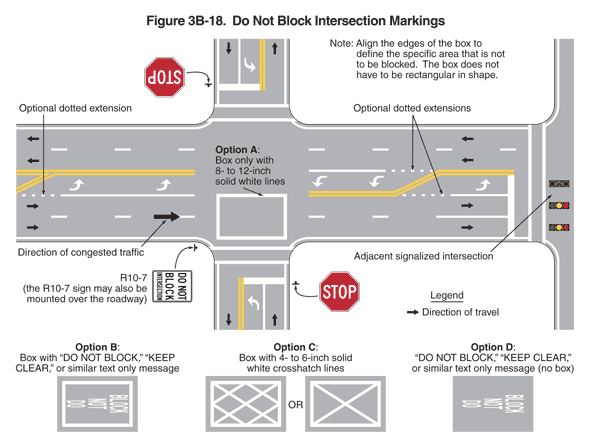|
|
2009 Edition Part 3 Figure 3B-18. Do Not Block Intersection Markings

Figure 3B-18. Do Not Block Intersection Markings
This figure illustrates an example of Do Not Block intersection markings. A legend shows a black arrow indicating the direction of travel in the lanes.
This figure shows the intersection of a five-lane horizontal roadway with a three-lane vertical roadway. The horizontal roadway intersects a second vertical roadway at the far right side of the figure. Arrows show that the direction of travel is two lanes eastbound and two lanes westbound with opposing center turn lanes on the horizontal roadway, and one lane northbound and one lane southbound with opposing center turn lanes on the vertical roadway. No direction of travel is shown on the second vertical roadway.
The horizontal roadway is composed of two through lanes in each direction and a center left turn lane. The vertical roadway is composed of one through lane in each direction and a center turn lane. On both roadways, the through lanes are divided from each other by a broken white line. The left turn lane is divided from the same direction through lanes by a solid white line, with an optional dotted white line extension in advance of the solid white line. The beginning of the left turn lane is shown by a solid double yellow line that angles from the broken white line to the solid double yellow line that separates the turn lane from the oncoming lanes. White turn arrows are marked in the turn lanes.
On the first vertical roadway, a solid white stop line is marked across all approach lanes at the intersection. To the right of the roadway at the white stop line, a STOP sign is shown. On each side of the intersection are two parallel solid white lines denoting crosswalks.
On the horizontal roadway, a large black right-pointing horizontal arrow denoting the direction of congested traffic is shown marked in the through lanes traveling left to right in advance of the intersection with the first vertical roadway. To the right of the right lane traveling left to right and at the intersection, an R10-7 sign is shown with the words "Do Not Block Intersection." A note states "the R10-7 sign may also be mounted over the roadway." Beyond this intersection and at the intersection with the second vertical roadway, a solid white stop line is marked across the lanes traveling left to right. Two parallel solid white lines denoting crosswalks are shown across all lanes just beyond the stop line. In the intersection, three symbols of stop lights (one for each left-to-right lane) are shown at the adjacent signalized intersection.
In the through lanes traveling left to right on the horizontal roadway, a box composed of solid white lines is shown marked on the pavement at the intersection with the first vertical roadway. A note states: "Align the edges of the box to define the specific area that is not to be blocked. The box does not have to be rectangular in shape."
Four options are shown for the box markings:
- Option A is labeled "Box only with 8- to 12-inch solid white lines." The example shows a box composed of solid white lines on the pavement.
- Option B is labeled "Box with "DO NOT BLOCK," "KEEP CLEAR," or similar text only message. The example shows a box composed of solid white lines with the words "DO NOT BLOCK" in white on three lines, reading from bottom to top.
- Option C is labeled: "Box with 4- to 6-inch solid white crosshatch lines." The example shows a box composed of solid white lines and filled with a series of white crosshatch lines to the left of the word "OR" and another box composed of solid white lines and filed with one crosshatch marking extending from the northwest to southeast corners and from the southwest to northeast corners.
- Option D is labeled "DO NOT BLOCK," "KEEP CLEAR," or similar text only message (no box)." The example shows a gray rectangle with the words "DO NOT BLOCK" in white on three lines, reading from bottom to top. There is no box composed of white lines.
